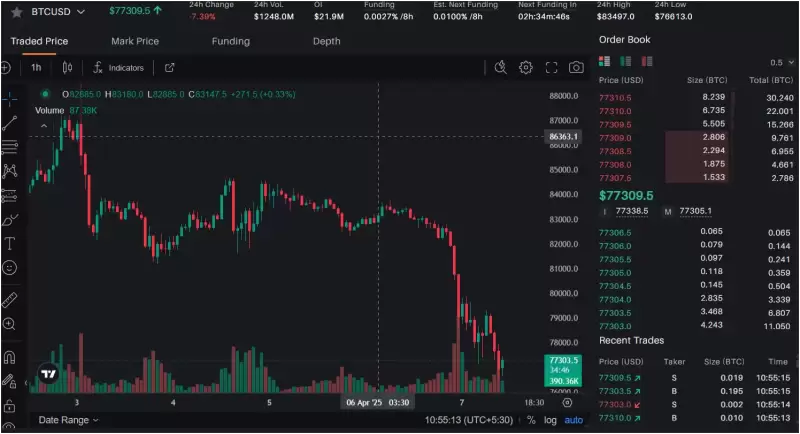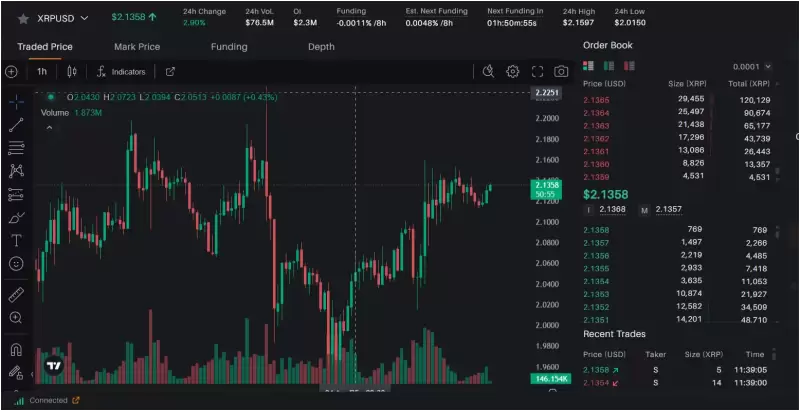 |
|
 |
|
 |
|
 |
|
 |
|
 |
|
 |
|
 |
|
 |
|
 |
|
 |
|
 |
|
 |
|
 |
|
 |
|
分散型デリバティブプロトコルは、分散型ファイナンス(DEFI)スペースの重要な革新として、従来の金融デリバティブ市場の運用モデルを徐々に変えています。彼らは、ブロックチェーンテクノロジーとスマートコントラクトを活用することにより、集中型仲介業者への依存を排除し、ユーザーに透明で安全な、グローバルにアクセス可能な取引環境を提供します。この記事では、高脂質、木星、ドリフト、GMX、頂点、頂点、シンフチャー、DYDXの8つの代表的な分散誘導体プロトコルの詳細な分析を実施します。目的は、読者に包括的で客観的な視点を提供して、この急速に進化する暗号金融スペースを理解するのに役立つことです。

Decentralized derivatives protocols are a crucial innovation in decentralized finance (DeFi), gradually transforming the operational model of traditional financial derivatives markets. These protocols eliminate the reliance on centralized intermediaries by leveraging blockchain technology and smart contracts. They offer users an unparalleled level of transparency, security, and global accessibility for trading various financial instruments. This article will delve into eight representative decentralized derivatives protocols: Hyperliquid, Jupiter, Drift, GMX, Vertex, Apex, SynFutures, and dYdX.
分散型デリバティブプロトコルは、分散型ファイナンス(DEFI)の重要な革新であり、従来の金融デリバティブ市場の運用モデルを徐々に変換します。これらのプロトコルは、ブロックチェーンテクノロジーとスマートコントラクトを活用することにより、集中仲介業者への依存を排除します。彼らは、さまざまな金融商品を取引するための比類のないレベルの透明性、セキュリティ、およびグローバルなアクセシビリティをユーザーに提供します。この記事では、高脂質、木星、ドリフト、GMX、頂点、頂点、シンフューチャー、およびdydxの8つの代表的な分散誘導体プロトコルを掘り下げます。
We will analyze the definition and characteristics of decentralized derivatives protocols, exploring their operational mechanisms in detail. Furthermore, we will introduce and highlight the features of each project, facilitating a comparative analysis. Finally, we will discuss the future outlook for this sector. The aim is to provide readers with a comprehensive and objective perspective to navigate this rapidly evolving crypto finance space.
分散型デリバティブプロトコルの定義と特性を分析し、それらの運用メカニズムを詳細に調査します。さらに、各プロジェクトの機能を紹介および強調し、比較分析を促進します。最後に、このセクターの将来の見通しについて説明します。目的は、読者に包括的で客観的な視点を提供して、この急速に進化する暗号金融スペースをナビゲートすることです。
1. Understanding Decentralized Derivatives Protocols
1.分散型誘導体プロトコルの理解
1.1 Definition
1.1定義
Decentralized derivatives protocols are financial instruments powered by blockchain technology that enable users to trade derivatives without the involvement of traditional centralized intermediaries. Derivatives are financial contracts whose value is derived from the price movements of underlying assets, such as BTC. Decentralized derivatives protocols utilize smart contracts to automate trade execution, settlement, and clearing processes. They operate on public blockchain networks, ensuring that the rules governing these protocols are transparent and immutable.
分散型デリバティブプロトコルは、従来の集中仲介者の関与なしにユーザーがデリバティブを取引できるようにするブロックチェーンテクノロジーを搭載した金融商品です。デリバティブは、その価値がBTCなどの基礎となる資産の価格移動から得られる金融契約です。分散型デリバティブプロトコルは、スマートコントラクトを利用して、貿易の実行、決済、およびクリアプロセスを自動化します。彼らはパブリックブロックチェーンネットワークで動作し、これらのプロトコルを管理する規則が透明で不変であることを保証します。
In contrast to centralized exchanges, like Binance or Coinbase, decentralized derivatives protocols do not rely on a single entity to manage user funds or match trades. Instead, they achieve decentralized market operations through distributed networks and algorithms. At present, perpetual futures are the most popular product type offered by decentralized derivatives protocols. These protocols allow users to leverage bets on the price changes of crypto assets without an expiration date.
BinanceやCoinbaseなどの集中交換とは対照的に、分散型デリバティブプロトコルは、単一のエンティティに依存してユーザーファンドを管理したり、取引を一致させたりしません。代わりに、分散ネットワークとアルゴリズムを通じて分散型市場運営を達成します。現在、永続的な先物は、分散型デリバティブプロトコルによって提供される最も人気のある製品タイプです。これらのプロトコルにより、ユーザーは有効期限なしに暗号資産の価格変更に対するベットを活用できます。
1.2 Characteristics
1.2特性
Decentralized derivatives protocols possess the following core characteristics:
分散型デリバティブプロトコルには、次のコア特性があります。
Decentralization: There is no centralized controlling entity. All trades are completed directly on the blockchain, minimizing single points of failure and reducing censorship risks.
地方分権:集中制御エンティティはありません。すべての取引はブロックチェーン上で直接完了し、単一の障害点を最小限に抑え、検閲リスクを減らします。
Transparency: Transaction records and contract terms are permanently stored on the blockchain, open for public access and facilitating the verification of trade fairness.
透明性:トランザクションレコードと契約条件は、ブロックチェーンに永久に保存され、公開アクセスのために開かれ、貿易公平性の検証を促進します。
Security: User funds and data are protected through smart contracts and cryptographic techniques, significantly lowering the risk of hacking or internal fraud.
セキュリティ:ユーザーの資金とデータは、スマートコントラクトと暗号化技術を通じて保護され、ハッキングや内部詐欺のリスクを大幅に低下させます。
Accessibility: Global users can participate with just a crypto wallet, no need for KYC (Know Your Customer) or permission from traditional financial institutions.
アクセシビリティ:グローバルユーザーは、暗号ウォレットだけで参加できます。KYC(顧客を知る)、または従来の金融機関からの許可を得る必要はありません。
Innovation: Decentralized derivatives protocols support a variety of financial products, including perpetual contracts, options, and synthetic assets, providing users with diverse trading strategies.
イノベーション:分散型デリバティブプロトコルは、永続的な契約、オプション、合成資産など、さまざまな金融商品をサポートし、ユーザーに多様な取引戦略を提供します。
These characteristics make decentralized derivatives protocols attractive not only to retail traders but also increasingly to institutional investors.
これらの特性により、分散型デリバティブプロトコルは、小売業者だけでなく、機関投資家にとってますます魅力的になります。
2. Operational Mechanisms of Decentralized Derivatives Protocols
2。分散型誘導体プロトコルの運用メカニズム
Decentralized derivatives protocols operate by integrating blockchain technology with various market mechanism designs to achieve liquidity provision, price discovery, and efficient trade execution. Let's examine several common operational mechanisms used by these protocols.
分散型デリバティブプロトコルは、ブロックチェーンテクノロジーをさまざまな市場メカニズム設計と統合して、流動性の提供、価格発見、効率的な貿易実行を実現することにより動作します。これらのプロトコルで使用されるいくつかの一般的な運用メカニズムを調べましょう。
2.1 Automated Market Maker (AMM)
2.1自動マーケットメーカー(AMM)
Automated Market Makers (AMM) replace the traditional buy and sell order matching model with algorithms and liquidity pools. Users deposit assets into liquidity pools, and the funds in the pool are used to adjust prices according to a preset mathematical formula, such as the constant product formula. For instance, in the case of Uniswap, the product of the two tokens remains constant.
自動化されたマーケットメーカー(AMM)は、従来の買いと販売の注文マッチングモデルをアルゴリズムと流動性プールに置き換えます。ユーザーは資産を流動性プールに預け、プール内の資金を使用して、一定の製品式などのプリセット数学式に従って価格を調整します。たとえば、Uniswapの場合、2つのトークンの積は一定のままです。
Representative projects: Jupiter, GMX.
代表プロジェクト:木星、GMX。
Advantages: AMMs are renowned for their simplicity and efficiency, making them particularly suitable for smaller trades and in highly volatile markets.
利点:AMMはシンプルさと効率性で有名であり、より少ない取引や非常に不安定な市場に特に適しています。
Disadvantages: AMMs may experience price slippage, and the price discovery efficiency of AMMs is generally lower than that of order books.
短所:AMMは価格の滑りが発生する可能性があり、AMMの価格発見効率は一般に注文書のそれよりも低くなります。
2.2 Order Book Model
2.2注文書モデル
The Order Book Model closely resembles the operation of traditional financial exchanges. Buyers and sellers submit limit orders, which are aggregated by the system to form an order book. The system matches buy and sell orders at the best available price and priority level. This mechanism is widely used by centralized exchanges but needs to be adapted to address on-chain transaction speed and cost limitations in decentralized environments.
注文書モデルは、従来の金融交換の運用に非常に似ています。買い手と売り手は、システムによって集約されて注文帳を形成するために集約されています。システムは、利用可能な最良の価格と優先度レベルで購入注文と販売と一致します。このメカニズムは、集中交換によって広く使用されていますが、分散環境でのチェーン上のトランザクション速度とコスト制限に対処するために適応する必要があります。
Representative project: Hyperliquid.
代表的なプロジェクト:Hyperliquid。
Advantages: Order books provide more precise price discovery and are suitable for professional traders who value optimal execution.
利点:注文書はより正確な価格の発見を提供し、最適な実行を重視するプロのトレーダーに適しています。
Disadvantages: Due to the performance limitations of current blockchains, achieving low-latency order book execution on-chain presents significant technical difficulties. This may lead to trade delays or high fees.
短所:現在のブロックチェーンのパフォーマンスの制限により、低遅延の注文帳の実行中の鎖を達成することは、重大な技術的困難をもたらします。これにより、貿易遅延や高額の料金につながる可能性があります。
2.3 Hybrid Model
2.3ハイブリッドモデル
The hybrid model aims to combine the advantages of AMMs and order books while attempting to find a balance between liquidity and trading efficiency. For example, a protocol may use AMMs to provide base liquidity and quickly execute smaller trades, while routing larger trades through an order book to achieve better price optimization.
ハイブリッドモデルは、流動性と取引効率のバランスを見つけようとしながら、AMMと注文書の利点を組み合わせることを目指しています。たとえば、プロトコルはAMMを使用して基本的な流動性を提供し、より少ない取引を迅速に実行し、より良い価格の最適化を達成するために注文帳を介してより大きな取引をルーティングする場合があります。
Representative project: Vertex.
代表プロジェクト:頂点。
Advantages: Hybrid models offer greater flexibility and adaptability to different market conditions.
利点:ハイブリッドモデルは、さまざまな市場状況により柔軟性と適応性を高めます。
Disadvantages: Hybrid models may have higher implementation complexity, and the user experience across different modules may not be uniform.
短所:ハイブリッドモデルは実装の複雑さが高く、異なるモジュールのユーザーエクスペリエンスが均一ではない場合があります。
2.4 On-chain/Off-chain Hybrid
2.4オンチェーン/オフチェーンハイブリッド
Some protocols execute order matching off-chain to improve speed and throughput. They manage settlement and user funds on-chain to ensure security and transparency
一部のプロトコルは、速度とスループットを改善するために、オフチェーンの一致する注文を実行します。セキュリティと透明性を確保するために、和解とユーザーの資金をオンチェーンで管理しています
免責事項:info@kdj.com
提供される情報は取引に関するアドバイスではありません。 kdj.com は、この記事で提供される情報に基づいて行われた投資に対して一切の責任を負いません。暗号通貨は変動性が高いため、十分な調査を行った上で慎重に投資することを強くお勧めします。
このウェブサイトで使用されているコンテンツが著作権を侵害していると思われる場合は、直ちに当社 (info@kdj.com) までご連絡ください。速やかに削除させていただきます。
-

- Raydium(Ray)は、プラットフォームが新しいMeme Coin Launchpadを起動すると10%急増し、Pump.Funの市場をターゲットにしています
- 2025-04-17 22:40:15
- 暗号通貨のエコシステム内でのエキサイティングな開発で、Raydium(Ray)は水曜日に大幅な10%の急増を見ました。プラットフォームは、新しいMeme Coin LaunchPadの発売を発表したため、LaunchLabを発表しました。この革新的なステップにより、RaydiumはPump.Funと直接競争します。これは最近、その分散型取引所(DEX)のPumpswapを発表しました。この動きは、ミームコインスペースを再構築し、旅を開始するためのプラットフォームを探している新しいプロジェクトを引き付ける可能性があります。
-

-

-

-

-

-

-

-




























































